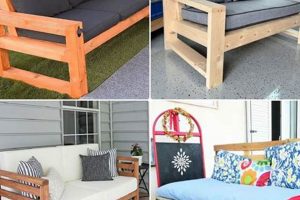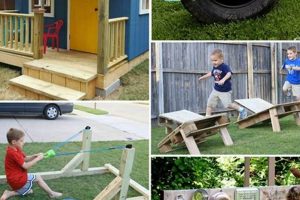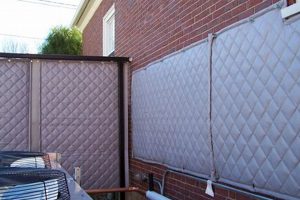Constructing customized recreational spaces within residential yards allows for tailored environments catering to specific developmental needs and preferences of children. These installations, built from readily available materials and personal effort, provide alternatives to commercially manufactured playground equipment. An example includes a sandbox built from repurposed tires and filled with play-grade sand.
These designed spaces foster creativity, physical activity, and social interaction in a secure, familiar environment. Historically, parents and communities have created such zones using available resources to supplement or replace formal play structures. The advantages extend to cost-effectiveness, personalized design, and the promotion of resourcefulness and practical skills within families.
The subsequent sections will delve into specific design considerations, material selection criteria, safety guidelines, and project implementation strategies for creating engaging and durable recreational spaces in outdoor settings.
Essential Considerations for Customized Outdoor Recreation Zones
The creation of a residential recreation zone requires careful planning and execution. The following guidelines provide a framework for successful implementation.
Tip 1: Site Assessment: Conduct a thorough evaluation of the intended area. Note sun exposure, existing vegetation, drainage patterns, and proximity to potential hazards (e.g., power lines, fences, bodies of water). This informs design and material selection.
Tip 2: Define Scope and Budget: Establish clear parameters for the project. Determine the types of activities the zone will accommodate (e.g., climbing, sliding, sand play). Allocate a realistic budget for materials, tools, and potential labor assistance.
Tip 3: Prioritize Safety: Select materials that are non-toxic, durable, and resistant to weathering. Implement appropriate safety surfacing beneath climbing structures (e.g., shredded rubber mulch, wood chips) to minimize impact injuries.
Tip 4: Consider Age Appropriateness: Design the zone to suit the developmental stage of the intended users. Infants and toddlers require different features than older children. Adjustable or adaptable components extend the lifespan of the zone.
Tip 5: Promote Natural Elements: Integrate existing trees and vegetation where possible. Incorporate natural materials such as logs, rocks, and water features (with appropriate safety measures) to enhance the sensory experience.
Tip 6: Plan for Maintenance: Establish a routine inspection and maintenance schedule. Regularly check for wear and tear, loose fasteners, and potential hazards. Replace or repair damaged components promptly.
Tip 7: Local Regulations: Research and comply with all local building codes, zoning regulations, and homeowner association guidelines pertaining to outdoor structures.
These considerations collectively contribute to a safe, engaging, and enduring recreational area tailored to the specific needs of its users.
The final section will provide a detailed guide on specific project implementation.
1. Safety Protocols
The integration of rigorous safety protocols is paramount in the construction of any residential recreational space. A failure to adhere to established guidelines directly increases the risk of injury to users, particularly children. Causative factors in play area injuries often include inadequate impact attenuation beneath play structures, sharp edges or protrusions on equipment, unstable structures, and the use of toxic materials. The absence of appropriate surfacing materials, such as certified playground mulch or rubber tiles, can result in severe head trauma from falls, a leading cause of emergency room visits for children. Similarly, improperly treated wood can splinter, posing laceration hazards.
Safety protocols encompass several critical stages, from initial design to ongoing maintenance. The selection of materials must prioritize non-toxicity, durability, and resistance to weathering. Construction techniques must ensure structural integrity, minimizing the risk of collapse or component failure. Regular inspections are essential for identifying and rectifying potential hazards, such as loose fasteners, cracks in materials, or overgrown vegetation obstructing visibility. Public playgrounds offer examples of adherence to safety standards, often displaying certification from organizations like the International Play Equipment Manufacturers Association (IPEMA), demonstrating compliance with ASTM standards. These standards provide detailed specifications for equipment design, surfacing, and maintenance procedures.
In conclusion, implementing thorough safety protocols constitutes an indispensable element of residential recreational construction. Neglecting this critical aspect directly compromises the well-being of users. Diligent adherence to established guidelines, coupled with regular inspection and maintenance, mitigates risks, providing a secure and enjoyable play environment. The challenge lies in translating complex standards into practical construction and maintenance procedures accessible to homeowners, emphasizing the importance of informed decision-making in all stages of the project.
2. Material Durability
The selection of durable materials is a foundational aspect of constructing sustainable and safe recreational spaces within residential settings. The long-term viability of these play areas hinges on the capacity of chosen components to withstand environmental stressors and the wear and tear associated with regular use. Inadequate material selection necessitates frequent repairs or replacements, increasing overall project costs and compromising safety.
- Resistance to Weathering
Exterior grade materials must exhibit inherent resistance to degradation from sunlight, precipitation, and temperature fluctuations. Untreated lumber, for instance, is susceptible to rot and insect infestation, necessitating pressure-treated options or naturally durable species like cedar or redwood. Plastics used in slides or climbing structures should be UV-resistant to prevent embrittlement and cracking. Metal components require rust-preventative coatings to maintain structural integrity.
- Impact Resistance
Materials utilized in high-impact areas, such as beneath swings or at the base of climbing structures, must possess sufficient resilience to withstand repeated stress. Engineered wood fiber (EWF) surfacing, for example, is designed to absorb impact energy, mitigating the risk of injuries from falls. Similarly, structural components like support beams require a high tensile strength to bear significant loads without deformation or fracture.
- Resistance to Biological Degradation
Outdoor environments foster the growth of mold, mildew, and other organisms that can compromise the integrity of organic materials. Pressure-treated lumber is impregnated with chemical preservatives to inhibit fungal growth and insect activity. Composite materials, constructed from recycled plastics and wood fibers, offer an alternative solution with inherent resistance to biological degradation.
- Abrasion Resistance
Components subjected to frequent contact, such as slide surfaces or handholds on climbing structures, require a high degree of abrasion resistance to prevent wear and maintain their functionality. Powder-coated metal surfaces or high-density polyethylene (HDPE) plastics exhibit superior abrasion resistance compared to traditional paints or softer plastics.
The interplay between these facets of material durability directly influences the longevity and safety of residential recreational zones. The initial investment in durable materials reduces the need for costly repairs or replacements over time. Selecting materials appropriate for the intended use and environmental conditions is paramount to ensuring a safe and enjoyable play environment for children. This proactive approach to material selection constitutes a critical element of responsible construction and maintenance.
3. Design Integration
The creation of a residential recreational space necessitates the seamless integration of design elements to ensure functionality, safety, and aesthetic harmony. Design integration, in the context of customized outdoor play areas, refers to the deliberate and cohesive combination of various components, including play structures, landscaping, surfacing materials, and safety features. Effective integration mitigates potential hazards, maximizes space utilization, and enhances the overall play experience.
The absence of proper design integration can manifest in several detrimental ways. For example, placing a swing set too close to a fence line presents a clear safety hazard. Similarly, selecting surfacing materials that do not adequately absorb impact energy increases the risk of injury from falls. From an aesthetic perspective, incongruous design elements can create a visually disjointed space, detracting from the overall appeal of the residential property. Real-world examples of successful integration include play areas where climbing structures are seamlessly connected to natural elements like trees or rock formations, creating a more engaging and stimulating environment. Also, surfacing materials that complement the surrounding landscape enhance aesthetic appeal.
Design integration, therefore, represents a critical facet of responsible construction, ensuring a harmonious balance between functionality, safety, and aesthetic considerations. Prioritizing thoughtful integration from the initial planning stages results in a recreational space that not only provides a safe and enjoyable environment for children but also enhances the overall value and appeal of the residential property. Challenges in achieving optimal design integration can include budgetary constraints, limited space, or pre-existing site conditions. However, careful planning and creative problem-solving can overcome these obstacles, resulting in a play area that seamlessly blends into its surroundings and meets the needs of its users.
4. Environmental Harmony
Environmental harmony, in the context of constructing recreational spaces, denotes the integration of natural elements and sustainable practices to minimize ecological impact and enhance the inherent value of outdoor areas. The design and implementation of such zones should consider the existing ecosystem, striving to preserve biodiversity, conserve resources, and promote environmental stewardship.
- Preservation of Existing Flora and Fauna
Construction activities can disrupt habitats and displace local wildlife. Retaining existing trees, shrubs, and native plants not only enhances the aesthetic appeal of the play area but also provides crucial shelter and food sources for animals. If vegetation removal is unavoidable, replacement with native species is recommended to restore ecological balance. Example: Integrating a play structure around a mature tree, rather than removing the tree to accommodate the structure.
- Sustainable Material Sourcing
The selection of materials should prioritize renewable resources, recycled content, and low-impact manufacturing processes. Using sustainably harvested wood, recycled plastic lumber, or locally sourced stone minimizes the environmental footprint of the project. Avoidance of materials containing harmful chemicals, such as treated lumber with chromated copper arsenate (CCA), is essential to prevent soil and water contamination. Example: Constructing a sandbox from reclaimed wood pallets instead of purchasing new lumber.
- Water Conservation and Management
Play areas often incorporate water features for aesthetic or recreational purposes. Implementing water-efficient irrigation systems, collecting rainwater for irrigation, and designing permeable surfaces to reduce runoff are effective strategies for water conservation. Proper drainage systems are crucial to prevent erosion and waterlogging, protecting the surrounding landscape. Example: Installing a rain barrel to collect water for watering plants in the play area.
- Waste Reduction and Recycling
Construction projects generate significant amounts of waste. Implementing a waste reduction plan, including separating recyclable materials and composting organic waste, minimizes landfill disposal. Repurposing existing materials, such as tires for planters or logs for climbing structures, reduces the demand for new resources. Example: Using recycled tires to create a colorful border around a garden area within the play space.
These practices, when integrated into the planning and execution of residential recreational spaces, contribute to a more sustainable and environmentally responsible design. Emphasizing environmental harmony ensures the project enhances, rather than detracts from, the surrounding ecosystem, fostering a sense of connection with nature and promoting environmental awareness among users.
5. Age-Appropriateness
The design and construction of customized outdoor play areas must prioritize age-appropriateness to ensure both safety and developmental stimulation for children. Play structures designed for older children present significant hazards to toddlers due to differences in physical capabilities and cognitive understanding. Conversely, play areas designed exclusively for toddlers may fail to provide sufficient challenges or stimulation for older children, hindering their development.
Age-appropriateness influences various aspects of play area design. Equipment height, spacing between components, and the complexity of activities must align with the intended age group. For example, climbing structures intended for preschool-aged children should feature lower heights, wider steps, and secure handholds. Swings designed for infants require full bucket seats with safety harnesses, while older children can safely use open swings. Sandboxes for toddlers should be shallow and easily accessible, while older children may benefit from larger, more complex sand play areas that incorporate water features. Neglecting these considerations can lead to injuries or developmental delays.
Ultimately, ensuring age-appropriateness in outdoor play area construction necessitates a thorough understanding of child development and adherence to established safety standards. While creating a universally appealing space may seem desirable, prioritizing safety and developmental appropriateness for the intended age group is paramount. Adaptive designs that can be modified as children grow offer a viable solution to extending the lifespan and utility of the play area. Consultation with child development specialists or playground safety inspectors can further refine design choices and ensure a safe and stimulating play environment.
6. Budget Constraints
Financial limitations significantly impact the scope, design, and material selection process in residential recreational construction. Resource allocation directly influences the feasibility and longevity of outdoor play areas, necessitating strategic decision-making to maximize value and ensure safety within budgetary parameters.
- Material Selection Trade-offs
Budgetary restrictions often dictate compromises in material quality. High-end materials, such as sustainably sourced hardwoods or commercial-grade playground equipment, may be prohibitively expensive. Cost-effective alternatives, like pressure-treated lumber or repurposed materials, require careful evaluation to ensure adequate durability and safety. The selection process must balance upfront costs with long-term maintenance expenses and potential safety risks.
- Scope and Complexity Limitations
Available funding directly influences the size and complexity of the play area. Elaborate designs featuring multiple play structures, extensive landscaping, or custom-built elements may exceed budgetary limits. Simplifying the design, prioritizing essential components, and phasing the construction process are common strategies for mitigating financial constraints. A smaller, well-designed space is often preferable to a larger, poorly executed one.
- Labor Costs and DIY Contribution
Professional installation services can represent a substantial portion of the total project cost. Homeowners often opt to perform some or all of the construction work themselves to reduce expenses. This approach necessitates possessing the requisite skills, tools, and time commitment. Balancing DIY contributions with professional assistance requires careful consideration to ensure safety and structural integrity.
- Phased Implementation and Future Expansion
Budget constraints can be addressed by implementing the project in phases. Initial construction may focus on core elements, such as a basic climbing structure or sandbox, with additional features added as funding becomes available. This approach allows homeowners to spread costs over time while still providing immediate recreational opportunities. Careful planning is essential to ensure that future expansions seamlessly integrate with the existing play area.
Budget constraints are an inherent aspect of residential recreational construction. Strategic material selection, scope management, DIY contributions, and phased implementation represent effective strategies for maximizing value and ensuring safety within limited financial resources. The successful integration of these considerations results in a sustainable and enjoyable outdoor play area that aligns with the homeowner’s budgetary capabilities.
Frequently Asked Questions
This section addresses common inquiries regarding the planning, construction, and maintenance of customized recreational spaces within residential environments. It provides concise answers to assist homeowners in making informed decisions.
Question 1: What are the primary safety considerations when constructing a DIY outdoor play area?
Critical safety factors include selecting non-toxic materials, ensuring proper impact attenuation beneath play structures, maintaining structural integrity to prevent collapses, and adhering to established safety standards such as those published by ASTM International. Regular inspections are also essential to identify and address potential hazards.
Question 2: How can the cost of a DIY outdoor play area be effectively managed?
Cost containment strategies include utilizing repurposed materials, phasing construction over time, performing some or all of the labor oneself, and carefully comparing prices from multiple suppliers. Prioritizing essential components and selecting durable, yet affordable, materials are also key considerations.
Question 3: What types of surfacing materials are recommended for minimizing the risk of injuries from falls?
Acceptable surfacing options include engineered wood fiber (EWF), shredded rubber mulch, rubber tiles, and poured-in-place rubber. The appropriate depth of the surfacing material depends on the fall height of the play equipment. Compliance with ASTM F1292 standards for impact attenuation is recommended.
Question 4: How can the environmental impact of a DIY outdoor play area project be minimized?
Sustainable practices include preserving existing vegetation, using sustainably sourced materials, implementing water conservation measures, and reducing waste through recycling and repurposing. Avoiding materials containing harmful chemicals is also essential.
Question 5: What are the key considerations for ensuring age-appropriateness in the design of a DIY outdoor play area?
Age-appropriateness factors include equipment height, spacing between components, and the complexity of activities. Play structures should be designed to match the physical capabilities and cognitive abilities of the intended age group. Adaptive designs that can be modified as children grow are also beneficial.
Question 6: Are there any legal or regulatory requirements that must be considered before constructing a DIY outdoor play area?
Local building codes, zoning regulations, and homeowner association guidelines may impose restrictions on the construction of outdoor structures. It is essential to research and comply with all applicable requirements before commencing any work. Failure to do so may result in fines or the forced removal of the structure.
Careful planning, adherence to safety guidelines, and a commitment to sustainable practices are essential for successfully creating customized recreational spaces within residential environments.
The subsequent section will provide resources to help with DIY Outdoor Play Areas.
Conclusion
The preceding discourse has elucidated critical considerations for establishing residential recreational zones. Safety protocols, material durability, design integration, environmental harmony, age-appropriateness, and budget constraints collectively influence the feasibility and longevity of such spaces. Successfully addressing each of these facets is paramount to creating a secure and stimulating environment for children.
The construction of a diy outdoor play area represents a substantial undertaking requiring meticulous planning and execution. While the allure of a personalized recreational zone is undeniable, prospective constructors must prioritize safety and sustainability to ensure a responsible and enduring addition to their property. Further research and professional consultation are advised before commencing any work.







